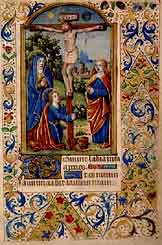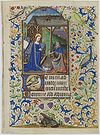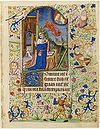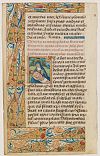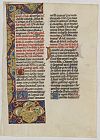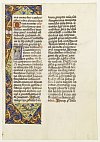The medieval Book of Hours evolved out of the monastic cycle of prayer which divided the day into eight segments, or "hours". Those of: Matins, Lauds, Prime, Terce, Sext, Nones, Compline, and Vespers. By
the early fifteenth century, the format of the Book of Hours had developed to satisfy the demands of private, as opposed to communal, devotion. These portable books are smaller in format than
their monastic forebears, designed for use by individuals, with a liturgical system somewhat less complicated than monastic liturgy and more "user-friendly." A Book of Hours invariably begins with a
liturgical calendar, listing feast days in chronological order along with a complicated method of calculating the date of Easter.
The seven Penitential Psalms are usually included as well, and
additional prayers (devoted to particular saints or personal issues) according to the desires and needs of the owner.
In Books of Hours are preserved some of the finest works of medieval art. Each section of the manuscript traditionally begins with an illuminated miniature that complements the prayers, to stimulate contemplation and meditation in the reader. Because they were expensive and spectacular works of art, the ownership of these manuscripts was limited mainly to royalty, nobility and the very wealthy. They are often adorned with coats of arms, and portraits of patrons may sometimes be found within the miniatures. As their popularity increased, an efficient system of book production and trade developed to match the demand for Books of Hours. Professional scribes produced the texts in one location, the miniatures were painted in artists' workshops, and the two brought together in the bookbinder's hall. Patrons could choose the texts and miniatures they wanted, or purchase complete, generic manuscripts in stationers' book shops. A thriving economy developed around the production of Books of Hours, especially in centers such as Paris, Bruges and Utrecht.
What is an illuminated manuscript?
An illuminated manuscript is a book written and decorated by hand. Its name is derived from the Latin manus meaning hand and "scriptus" meaning writing. Manuscripts which were decorated with gold, silver or bright paint ,are called illuminated, from the Latin "illuminare" meaning to lighten or brighten up.
A large number of manuscripts are covered with painted ornaments
which may be presented under several forms:
* initials of chapters or paragraphs, ornamented sometimes very simply, sometimes on the other hand with a great profusion of interlacings, foliage, and flowers; these are developed along the
the whole length of the page and within are sometimes depicted persons
or scenes from everyday life;
* paintings on the margin, in which some scene is carried over
several pages;
* borders around the text (interlacing colonnades, etc.), the most remarkable example is that of the evangelistic canons of the Middle
Ages;
* full-page paintings (or such as cover only a part of the page),
but forming real pictures, similar to frescoes or easel pictures;
these are chiefly found on very ancient or very recent manuscripts
(fourteenth and fifteenth centuries);
How were illuminated manuscripts made?
During the medieval period, books were written and decorated on parchment, a type of animal skin. Most parchments came from cow skins, which were prepared through an elaborate process that involved soaking, scraping, drying and treating the skins. The finest quality parchment, noted for its thin and supple character, was called vellum. Once the necessary number of vellum skins were prepared and cut to size for pages, they were then marked along both margins with small pinholes. Using these holes as a guide, lines were then inscribed or drawn on the page to establish the layout for the scribes and decorators.
Following this, a calligrapher or scribe would write on the parchment with a reed or feather quill pen. In the early Middle Ages, the best quills came from several varieties of geese found off the coast of England. The scribe used an ink derived either from carbon soot or gall nuts. In one method, carbon soot from beeswax candles or linseed oil lamps was combined with gum arabic to produce an indelible black ink. In the other, gallnuts, the swollen nodules produced by certain insects living in oak trees, were mixed with iron salts, making an ink that eventually turned brown from exposure to the atmosphere.
While the main body to the text was usually written in black or
brown ink, colored lines of writing, called rubrics (from the Latin
rubrica meaning red), were most often, but not always, written in
red. Rubrics served as instructional guides to the reader,
providing descriptive headings and marking divisions in the text.
Rather than write original works spontaneously onto the page,
medieval scribes, more often than not, copied their work from model
texts, called exemplars. When the text was completed, the
manuscript was decorated or illuminated in the blank spaces the
scribe had intentionally left for the illuminator.
See our inventory of Medieval Manuscripts for sale.
How were illuminated manuscripts decorated?
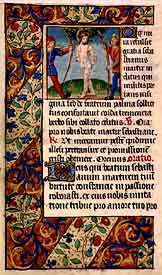
The illuminator, who was a specialist distinct from the scribe, had a repertoire of visual motifs which he, or she, employed to decorate the manuscript according to the nature of the text and the expense of the commission. Letters that began new chapters or important passages in the book could be decorated or historiated. Decorated letters were embellished with geometric, foliate, and zoomorphic designs, or with mixed elements of all three. Historiated initials, deriving their name from the French "ystoire", served as frames that enclosed small figural or narrative scenes.
To further enliven the text, the margins of the page were often adorned with decorated borders. Their decoration varied from small line drawings of a whimsical character, known as "drolleries," to elaborately painted floral patterns filling the entire border. In some instances, small scenes were incorporated into the border in the form of medallions called roundels or rectangular panels in the lower margin.
For more expensive commissions, paintings known as miniatures were often included in the decorative program. Miniatures are named not for their small size but from the Latin word "minum", which is a red pigment used in paint. Miniatures enhanced the beauty of the book with narrative and symbolic scenes. Their functions ranged from illustrating the text and dividing the book into sections, to serving as devotional icons and aids to study and prayer. Within this context, a diverse range of regional and personal styles developed; making each manuscript unique in both style and content.
The paint used to decorate manuscripts and paint miniatures came from a variety of sources including oxidized metals as well as vegetable and animal matter in a tempera base. Vermilion was made from mercury and sulfur, while ultramarine blue, a pigment as expensive as gold, was made from crushing lapis lazuli, a semi-precious stone imported from Afghanistan during the Middle Ages. Materials were very expensive, and sometimes substitutes for real gold were used.
Before the thirteenth century, medieval manuscripts were initially produced in monasteries by monks working in the scriptorium, or writing room where books were made. More than five hundred monasteries existed in England alone by the twelfth century, and a typical monastic library might possess over three hundred books in its library. By the beginning of the thirteenth century, the growth of towns and the establishment of universities in Paris, Oxford, and Bologna led to the rise of secular scribes and artists who served students and professors as well as the nobility.
Later in the fourteenth century, a rise in literacy and the development of an upper-middle-class created a large demand for illuminated manuscripts. The production of illuminated manuscripts of prayer books for personal devotions, called Books of Hours, increased dramatically.
Paints
The medieval artist's palette was surprisingly broad. In addition
to the substances listed below, unlikely-sounding substances such
as urine and earwax were used to prepare pigments.
Colour Source(s)
Red Mercury(II) sulfide (HgS), often called cinnabar or
vermilion, in its natural mineral form or synthesized; "red lead"
or minium (Pb3O4); insect-based colors such as cochineal, kermes
and lac; rust (iron oxide, Fe2O3) or iron oxide-rich earth
compounds
Yellow Plant-based colours, such as Weld, turmeric or
saffron; yellow earth colors (ochre); orpiment (arsenic sulfide,
As2S3)
Green Plant-based compounds such as buckthorn berries;
copper compounds such as verdigris and malachite
Blue Ultramarine (made from the rock lapis lazuli) or
azurite; smalt; plant-based substances such as woad, indigo, and
folium or turnsole
White Lead white (also called "flake white", basic lead
carbonate (PbCO3)); chalk
Black Carbon, from sources such as lampblack, charcoal, or
burnt bones or ivory; sepia; iron and gall
Gold Gold, in leaf form (hammered extremely thin) or
powdered and bound in gum arabic or egg (called "shell gold")
Silver Silver
How do manuscripts acquire value?
Medieval and renaissance illuminated manuscripts have never been without substantial value. Because of their striking beauty and great allure, many have been considered treasures from the time of their creation to the present day. In the inventories of kings and dukes who commissioned them, manuscripts were listed among their most precious objects with great care. Many illuminated manuscripts were made for or collected by the world's most powerful men and women, who possessed expensive and refined taste.
Almost ten centuries ago, lavishly illuminated biblical
manuscripts or treasure books were made for the Carolingian and
Ottonian emperors of Germany. These illuminated Gospels numbered
among the most valuable items in the imperial treasury, where they
were stored and displayed with other treasures to proclaim the
wealth and status of the owner. It is no coincidence that one such
book, the Gospels of Henry the Lion, sold at Sotheby's auction
house in 1983 for almost 12 million dollars - the highest price
ever paid for a work of art at the time.
See our inventory of Medieval Manuscripts for
sale.
Later generations of medieval royalty, especially in France, commissioned and collected a variety of illuminated manuscripts. Among the greatest of these medieval bibliophiles were Jean, Duke of Berry, and Charles the Bold, Duke of Burgundy. The libraries they formed have become legendary, and their contents now constitute the nucleus of many of the world's greatest institutions.
To the modern collector, illuminated manuscripts represent the finest examples of Western painting from the medieval period Their jewel-like quality inspires a passion which transcends time. Such noted figures as John Pierpont Morgan, Collis Huntington, Henry Walters, Robert Lehman, and John Paul Getty Jr. have all avidly collected important medieval and renaissance manuscripts and miniatures.
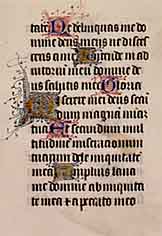
Today, manuscripts are collected in the form of complete books, known as codexes, and as single leaves (individual pages) and cuttings (cut-out portions of pages). High-quality examples are uncommon and of considerable value. The collecting of single leaves and cuttings dates back to at least the eighteenth century when many miniatures were separated from their texts to be appreciated and displayed independently as small works of art by celebrated collectors of paintings and drawings. In England, an import tax on books by weight encouraged the wholesale destruction of many large heavy Italian manuscripts, from which the illuminated initials were cut.
Illuminated manuscripts retain significance today not only for their great aesthetic appeal, but also for their depth as sophisticated cultural objects which may be appreciated in a great variety of ways. As great drawings, illuminated manuscripts represent some of the finest artistic production of the medieval period in its original unrestored state. This is in contrast to panel paintings of the same time which have often been heavily restored and cost several orders of magnitude more than manuscripts. Even textual pieces with minimal painting are highly valued as some of the best examples of the waning art of calligraphy. Stories of the sale and purchase of great manuscripts are among the most colorful and legendary in the history of the world's most renowned auction rooms.
Acanthus - A type of leafy plant commonly depicted in foliate borders.
Antiphonal - The book containing the principal music sung by the choir during the Divine Office.
Bifolium - A piece of parchment which is folded to create two leaves.
Binding - Animal skin, cloth or metal covering wooden boards that are sewn together with the vellum leaves at the spine.
Book of Hours - A very popular type of text during the Middle Ages used for private devotions. It contains a calendar as well as psalms, prayers, hymns and biblical readings for recitation during the eight canonical hours of the day, known as the Hours of the Virgin.
Border - The margin around the text, which is often illuminated with foliate designs
Breviary - A liturgical book used for the celebration of the Divine Office.
Choir Books - The general term for service books containing the music sung by the choir, e.g. Antiphonal and Gradual.
Codex - A collection of written pages stitched together along one edge, the book form still in use today.
Cutting - A section of a leaf, often containing illuminated initials which have been cut from a manuscript.
Decorated Initial - A painted initial with geometric or naturalistic designs. See also Historiated Initial, Inhabited Initial and Zoomorphic Initial.
Folio - A leaf of a manuscript that is numbered on only one side, usually the recto.
Book hand - A type of script common in many medieval manuscripts of the 14th and 15th centuries which consists of rectangular letter forms.
Hours of the Virgin - The core text of the Book of Hours containing reading and devotions to the Virgin Mary. The eight hours are Matins, Lauds, Prime, Terce, Sext, None, Vespers and Compline.
Humanist Script - A type of script reminiscent of classical carved writing, noted for its clarity.
Inhabited Initial - An illuminated initial which contains a human or animal figure.
Leaf - A single page of a manuscript. The front surface, which appears on the right side of a two-page opening, is called the recto, and the back surface, which appears on the left side is called the verso. Leaves are most often written on vellum.
Miniature - An independent painting in a manuscript which generally illustrates the text. The name derives not from their relatively small size but from the Latin word minum, which is a red pigment used in paint.
Missal - The service book containing the texts necessary for the recitation of the Mass in Christian liturgy
Parchment - The material derived from animal skins upon which most western manuscripts were written before the 15th century.
Psalter - The Book of Psalms with a calendar and other devotional texts used in the Christian liturgy and for private devotions.
Rinceaux - A type of fine branched ivy decoration frequently used in border decoration.
Roundel - A round narrative painting contained within the border.
Rubric - Colored lines of writing (from the Latin rubrica meaning red), were most often, but not always written in red and served as instructional guides to the reader, providing descriptive headings and marking divisions in the text.
Scriptorium - The place in monasteries and churches where manuscripts were made.
Vellum - A very fine type of Parchment known for its supple character.
Versal - The enlarged first letter of a word marking the beginning of a section of text
Zoomorphic Initial - An illuminated initial comprised of animal forms.
